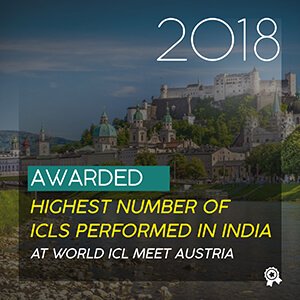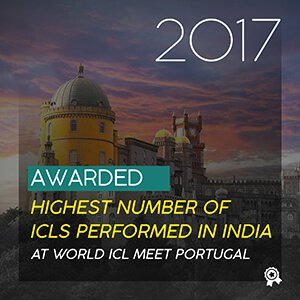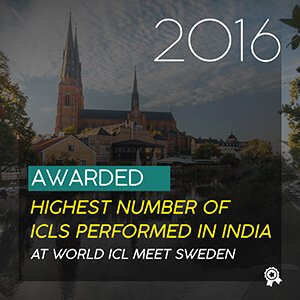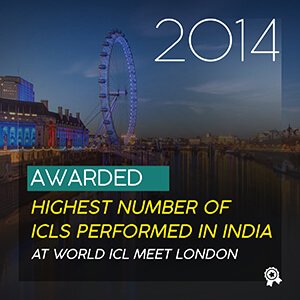Eye7 Hospitals get into Indian Record Books for performing maximum ICL Specs Removal Procedure in India
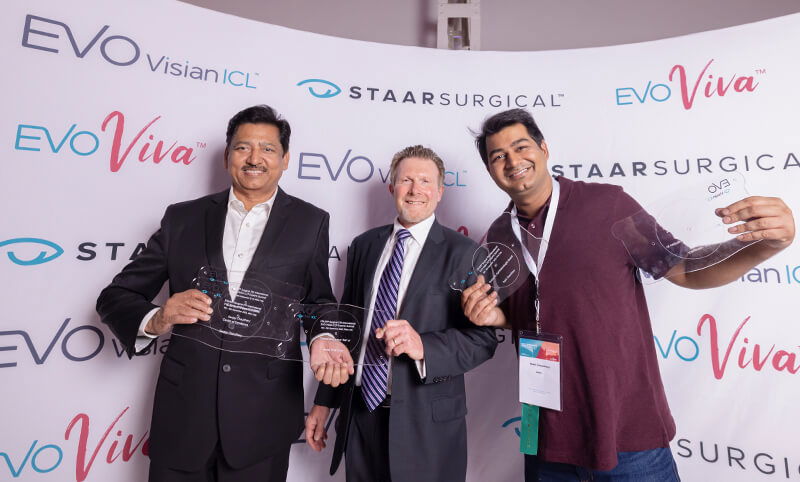
Awarded for highest number of ICLs implanted in India in 2022, at World ICL Experts Summit, Milan, Italy
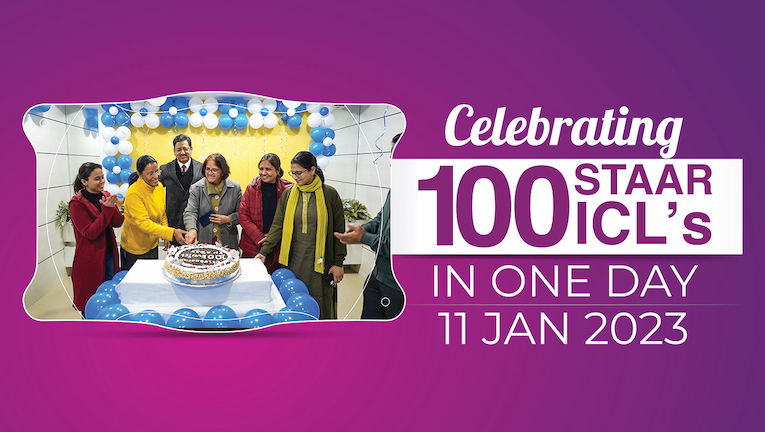
Eye7 Eye Hospitals created an INDIAN RECORD by performing 100 ICLs in 1 day
If you wear corrective eyewear such as glasses or contact lenses and would like to be free of the encumbrance, then there are several options which provide permanent vision correction. Although LASIK surgery is the most well-known method to correct vision, there are other options for people who may not want to permanently alter their cornea or who may not be suitable candidates for LASIK.
ICL, also very commonly referred to as Phakic IOL’s, are micro thin lenses implanted over the natural lens, inside the eye, to correct spectacle power. They are similar to contact lenses placed in eyes except that a contact lens is temporary and has to be put on a daily basis whereas ICL is put inside the eye permanently. The vision with an ICL is better than that of a contact lens because it is placed closer to the focus point in the eye and does not move creating irritation and dry eye.
ICL gives crisp, clear vision and does not require creating a corneal flap and corneal tissue removal as in LASIK, SMILE & other laser specs removal procedures. It also does not cause any corneal dryness as seen in standard laser spec removal processes. The ICL procedure provides a safe and effective surgical correction of powers as high as -20D and cylindrical correction of 6D.
Get in touch with us to know how ICL can help you get rid of glasses.
Watch, How ICL Surgery is Performed?
Who is a Candidate for ICL Surgery?
To be a suitable candidate for ICL, you should be:
- At least 18 years old
- Your specs number should be stable for about a year – minor changes do not disqualify you from becoming a candidate
- Ladies shouldn’t be pregnant or on breastfeeding
- You should not have any eye disease
- Controlled diabetes is not a contraindication.
Absolute Indications for ICL
- Eye power more than -8 diopters
- Cornea thinner than 450 microns
- Cylinder power of the eye more than 3.5 diopters
- Unhealthy cornea including Keratoconus
- Dry eye situations
- Any situation where LASIK is not a suitable option
Relative Indications for ICL
All indications for Contoura Vision/LASIK/SMILE are also indications of ICL as it is considered to provide crisp, clear vision and is not tampering with the cornea as in the case of Contoura Vision/LASIK/SMILE procedures.
Over 3 Million ICL’s have been implanted worldwide over the last 30 years. ICL is the best option in specs power of -8 or more. In lower powers, they are preferred when the cornea is thin, if you have dry eyes and LASIK is not advisable.
Types of ICL
ICL is made in Switzerland and USA, and the order for the lens is placed as per measurements of the eye. The lens is then received by courier in about two week’s time.
ICL is of 2 types, ICL Spherical (nearsighted or farsighted correcting) and ICL Toric (astigmatism correcting). Spherical ICL lens corrects only spherical power of glasses while Toric ICL lens corrects cylinder along with spherical power of glasses.
Below is a comparison of both:
ICL TORIC
FOR SPHERICAL & CYLINDRICAL NUMBER CORRECTION
| STITCH-LESS |
| BEST VISUAL OUTCOMES |
| US-FDA APPROVED |
ICL SPHERICAL
FOR SPHERICAL NUMBER
CORRECTIONS
| STITCH-LESS |
| BEST VISUAL OUTCOMES |
| US-FDA APPROVED |
Benefits of ICL
Precise Vision Correction
ICL has been approved in Europe since 1997 and in the U.S. since 2005. In that time, over 3 Million eyes have been implanted with ICLs by certified, specialized surgeons with study showing a 99.4% patient satisfaction rate. In addition to that, one also gets the following benefits:
- No dry eyes
- High definition vision which is sharp and crisp
- Excellent Night Vision
- Preferred choice in thin corneas
- UV protection is inbuilt in ICL
- A typically quick, 15-minute procedure and most people can resume daily activities in just a few short days with clearer vision
- For added peace of mind, the ICL is removable
For people who value health and wellness, the ICL surgery could be the choice for you. The Collamer base of the lens material is 100% biocompatible, meaning it is designed to function in harmony with your body’s chemistry.
Peace of Mind
The ICL can give you the freedom to live a life uninhibited by the day-to-day lifestyle demands of glasses and contacts. Your favorite activities and new adventures are on the horizon usually in a few short days.
One of the most common concerns people have about the laser-based correction is that the procedure permanently changes the shape of their eye by removing corneal tissue. The advantage of the ICL is that it can permanently correct your vision yet no natural tissue is removed or reshaped in any way during the procedure. If for the unlikely reason you need or wish to remove your ICLs in the future, your doctor can accommodate you.
ICL Surgery in Delhi – Top Eye Surgeons at Eye7 Chaudhary Eye Centre
Dr. Sanjay Chaudhary is one of the pioneers of ICL technology in India and has been implanting ICL’s for more than 12 years. He is one of the best ICL surgeons in Delhi with the highest volume of ICL surgeries all over India. He has been awarded “Highest Number of ICL Implanted in India” for the year 2014 (London), 2015 (Barcelona), 2016 (Sweden) & 2017 (Lisbon).
Dr. Chaudhary has also demonstrated LIVE ICL surgeries at several conferences. He is a regular participant at all ICL International users meet and has made several presentations in these international conferences. His more than 36 years of experience includes pioneering new technologies to restore vision to his patients, performing live surgeries during international ophthalmologic conferences, presenting papers detailing management of ICL surgeries and creating videos that provide detailed patient information about all the aspects of ICL. He has also contributed to books and professional journals.
Dr. Chaudhary considers restoration of good vision to be both an art and a science. He strives to inspire confidence and trust through experience and excellence in professionalism. His goal is to enrich the lives of his patients by bringing light to their eyes through quality care.
At Eye7 Chaudhary Eye Centre, rated as the best eye hospital in Delhi for ICL, your vision and the condition of your eyes are first evaluated. Recommendations for treatment are made based on the visual outcome you desire, your budget and your health. Because each eye is unique, the shape, health, and dimensions of your eye will determine whether you are a candidate for LASIK or would get better results from another procedure. Many people who are not able to have LASIK surgery get excellent results with ICLs.
ICL -Specs Removal for up to -30 Power
A thin cornea patient with -4.5 D power get ICL surgery for Specs Removal
ICL Surgery – Specs Removal in Keratoconus Patients
Lenses Used in Surgery – EVO Implantable Collamer Lenses (EVO ICL)
At Eye7 Chaudhary Eye Centre, only the EVO Implantable Collamer Lens made by STAAR Surgical of California, USA is used. EVO ICLs are approved by the U.S. Food and Drug Administration. Although other manufacturers also make Implantable Collamer Lenses, the EVO brand is reliable with over 30 years of history and performs very well. They are made of collagen, a naturally occurring substance that is compatible with the human body. Collamer has been used for many years as an implantable material in the eye.
The EVO ICL also contains an ultraviolet ray filter to protect the eyes from the harmful effects of sunlight. The latest version of the EVO ICL allows the aqueous humor, the natural fluid within the eye, to flow through a hole in the lens. The flow of fluid enhances the natural environment around the lens.
The lens is implanted in front of the natural lens of your eye just behind the iris. The micro-thin, clear lens cannot be felt and does not require any maintenance. Unlike a contact lens that is placed on the front of the eye and is removable, the ICL lens is permanent. However, the procedure is reversible for added peace of mind, and the lens can be removed.
The implant surgery is done on an out-patient basis and takes less than an hour to perform. The implant generally has very few side effects and is usually without complication. Severe complications occur in less than 1 percent of patients. However, as with any surgery, there are risks. With the EVO ICL, most are treatable.
Cost of ICL Surgery in Delhi
In an overview of the price of ICL surgery in Delhi, the ICL implants range from approximately INR 80,000 to INR 1,25,000 per eye (approx.). The cost of EVO Implantable Collamer Lenses may seem high at first glance. However, when you consider that the EVO ICL implant is permanent, you may save money over the long term.
There is not a preset fee for a EVO lens. The cost depends on your prescription, your doctor and where you have the procedure done. EVO ICL costs more than LASIK surgery. Costs factored into the procedure include:
- A thorough exam and pre-surgical screening to ensure proper fit and prescription.
- A custom-made lens of high-quality and proprietary material.
- Hospital and surgeon’s fees.
- Post-procedure follow-ups.
When you compare costs of an implant to a pair of eyeglasses, you may spend the same or more over a period of 10 years for the glasses. If you have a strong prescription, you may opt for thinner lenses, which cost more. When you include UV, anti-glare and anti-scratch coatings, the price of spectacles increases dramatically. Frames also add to the price. A single pair of spectacles can easily cost a lot of money. You can easily end up spending as much as the surgery over a period of 10 years.
After an ICL implant, 95 percent of the patients do not need glasses or contact lenses. If you are in the 5 percent of people who may need external vision aids after an ICL implant, there are ways to achieve better visual acuity. If you are over 45 years old, you may need reading glasses.
After an initial consultation to evaluate your unique eye condition, Dr. Chaudhary can better inform you about the cost of surgery.
Latest News in ICL
- Awarded for highest number of ICLs implanted in India at World ICL Experts Summit, Milan, Italy
- Dr. Rahil Chaudhary becomes the first eye doctor in the world to visit the ICL Manufacturing Plant, Switzerland and be a part of the global phakic IOL research team.
- Celebrating Highest Number of ICL Implants Performed in India in 2021
FAQs About ICL
ICLs are very very safe procedures. These procedures are also US-FDA approved, which means they have been given safety clearance for Human Eyes. However, like any other surgical procedure, it can have some complications which are extremely rare if a proper screening check is done before the process. Some of the risks include infection, increased intraocular pressure, and the possibility of accidental damage to the crystalline lens during the procedure. Some patients may experience some discomfort during the healing process (like dry eyes, light sensitivity), but these effects are temporary. Your doctor will discuss with you the risks and benefits of the procedure during your consultation. Nobody in our surgical experience has ever lost sight due to this procedure.
There are other variants of ICL manufactured by other companies, and a leading Indian brand manufactures a version called EyePCL.
At our centre we use only the US-FDA approved Staar Surgical ICL, not the Indian Version EyePCL.
An ICL has to fit perfectly in a space within the eye, and therefore ICL size and parameters have to be customized to individual eye. The small size ICL will be loose and make it float around. A large size will make it too tight and disturb adjoining areas. It is similar to a custom fitted suit. Even the slightest variation can disrupt final outcomes.
ICL Screening is the most crucial step is the entire process. For an ICL to go within the eye, the eye should have a natural space for it. This space is called the Anterior Chamber Depth (ACD). Ideally, the ACD should be 3.0 mm or more, but anything more than 2.75 mm is acceptable for a new generation of ICL.
Besides ACD other parameters to be checked are, accurate spectacle power of the eye, open angles of the eye, size of the cornea which is termed as white to white, the curvature of the cornea which is termed as Keratometry and the corneal thickness which is termed as Pachymetry.
Retina evaluation is a must and should be done by a retina specialist. It is because ICL are usually done in high spectacle powers called high myopia. The retina is weak in such eyes and can be associated with retina breaks and holes. Such lesions run the risk of retinal detachment, and preventive management is essential. The prevention is very simple and requires retina photo-coagulation which is a painless, non-touch, 5-minute procedure. It takes about 2-3 weeks for retina lesions to stabilize after which ICL can be implanted.
Yes. At Eye7 Chaudhary Eye Centre, we operate both eyes on the same day. However, if required, one eye can be operated at a time by choice.
The whole procedure usually takes 15 to 30 minutes, depending on whether the doctor has decided to operate one eye each time, or will be operating on both eyes sequentially on the same day.
The procedure doesn’t cause any pain. There might be a little pressure during the whole process. After the procedure, for the next three to four hours, there can be some discomfort but that is easily taken care of by simple medicines. One should contact their ophthalmologist in case there is any pain afterwards.
The pre-operative evaluation is entirely painless but takes around two hours for a complete, comprehensive check.
Generally, the operation is done in one day. However, before the treatment, one has to get a screening workup done which includes different types of investigations and takes about 2-3 hours. ICL sizing’s are calculated by eye specialists, and the order is sent to Staar Surgical to Switzerland and USA. If a custom fit size is available, the lens is received in India within two weeks however if a new lens is to be manufactured it will take about 6 to 7 weeks. Depending upon the condition of the eyes, it can take from one to two weeks to fully recover and do your daily jobs.
Most of the people, approximately 95 percent, will never need glasses again. The remaining 5 percent will have their dependency reduced on glasses. Your surgeon will explain this difference to you better.
Usually, four weeks.
You can consult your doctor for more details. If there is a need, your doctor will recommend you to use specs or cosmetic contact lenses.
Yes but please consult your doctor before using any type of makeup.
After ICL treatment, eye behaves like a normal eye. It means that you may require glasses for reading after 40 due to the normal aging process of an eye.
No. You can just let your doctor know about all your prior treatments and he will make the best choice for you.
Usually, the contact lens wear has to be discontinued for three days before you come for ICL workup and Surgery. However such should be discussed with your doctor who can suggest you the precautions in advance.
The lens is designed to remain in place permanently; a qualified ophthalmologist can remove or replace the implant, if required.
No. Since the lens is positioned behind the iris (the colored part of the eye), it is invisible to both you and observers.
The ICL is designed to be utterly unobtrusive after it is put in place. It stays in position by itself and does not interact with any of the eye’s structures.
One advantage of the ICL is that it offers treatment flexibility and it is entirely reversible If there is any change is the vision, which is extremely rare, the ICL can easily be removed and replaced. If necessary, another procedure can be performed at any time. Patients can wear glasses or contact lenses as needed following treatment with the ICL. The implant does not treat presbyopia (difficulty with reading in people 40 and older), but you can use reading glasses as needed after receiving the ICL.
The ICL is placed just behind the black part of the eye iris in front of the natural crystalline lens.
It is an extremely rare possibility because ICL is made of Collamer, which is a highly inert and biocompatible material and has not caused any problem for last 20 years, so it is unlikely it will cause any problem in future.
Visit the official website of ICL: https://www.discovericl.com/
IOL is an artificial lens which is implanted after removal of the natural lens usually in Cataract surgery. In ICL surgery, the natural lens is not removed, but the ICL is placed on top of the natural lens.
Yes, ICL is a safe option for all of the above.
ICL surgery is a safer and more effective option for these patients in case they want to avoid glasses or contact lenses since ICL surgery does not involve removing a part of the corneal tissue to correct the refractive error, unlike conventional laser surgery.
A subgroup of Keratoconus patients who can benefit significantly from ICL surgery are those who whose disease is stable and has stopped progressing. Once the condition has stabilized, that is, there is no change in the refraction in the eye or the power of glasses, with no surgical intervention for two years, Toric ICLs can offer these patients a better quality of life.
Eyes having riboflavin-ultraviolet-A collagen cross-linking (CXL or C3R) tend to have a fluctuation in refraction in the initial post-treatment. After the refraction stabilizes, these patients may be offered ICL surgery.
Similarly, in patients with an off centre cone, the surgeon may first offer the use of adjunct Intracorneal Ring Segments (ICRS) to centralize the cone. Once the keratoconus is stabilized, better sight without glasses may be offered by the use of ICL.
However, there are three major caveats to this:
- The visual results obtained after ICL surgery in severe keratoconus are less predictable than in patients without keratoconus
- The vision obtained with the use of Toric ICL in severe keratoconus is same as the best-corrected vision with glasses or soft contact lenses. It is believed that keratoconus associated corneal aberrations would have an impact on the final visual quality.
- Before considering a keratoconus patient for ICL surgery, the surgeon must establish that the refractive status of the eye has been stable for at least two years, In addition to that, the central cornea must be clear, with a keratometry reading of =52.00 D and a central or centralized cone.
The use of ICLs for correcting the refractive error in keratoconus is an off-label use of the lens, even though it is widely practiced and accepted by both patients and ophthalmologists all over the world. Keratoconus patients unfit for corneal procedures and intolerant to refractive correction by spectacles or contact lenses have significantly benefited from Toric ICL implantation alone or as an adjunct with other surgical procedures to correct the refractive errors associated with keratoconus after proper informed consent from the patients.
Refractive surgeries are elective surgeries, and best planned after having the baby, and preferably six months after stopping breastfeeding. That said, there have been several cases where LASIK or ICL surgery has been performed, not knowing that the lady having the surgery was pregnant, with no harmful effect to either the baby or the mother.
As a part of the pregnancy-induced changes in the mother’s body, hormones can cause decreased tear production, leading to dry eyes. It manifests as irritation and redness, especially in patients who wear contact lenses. The water retention in the body caused by the hormonal changes also affects the eyes. The curvature of the cornea changes, and consequently, the power of your glasses. It results in the fluctuation of vision that is often reported during pregnancy. The fluctuation of vision is much more in people with diabetes.
In case you were to have the ICL surgery for removal of glasses during pregnancy, and the eyes were to return to the pre-pregnancy state, you would need glasses again. Also, since there is no algorithm to determine how much of the change in power will come back, the doctor cannot rely on your pre-pregnancy glasses either to determine the exact power of the ICL. That is why the doctors advise that it is better to wait until the refractive power of the eye has stabilized before considering the surgery.
Another consideration to avoid elective surgery during pregnancy is that the eye drops used during and after the surgery may be absorbed into your bloodstream and reach the growing baby. This quantity is minimal, and there is no evidence that it can potentially harm the fetus, but doctors generally feel that it is best to defer surgery unless necessary.
The answer to this is simple. Do not panic. You are not the only one. Several young women have had ICL surgeries, only to find out that they were pregnant at that time. There have been no reported harmful effects to their eyes, or to the growing babies. In fact, some people use this as an argument to allow the surgery during pregnancy.
ICL vs LASER SPECS REMOVAL (CONTOURA VISION/LASIK/SMILE)
CONTOURA VISION, LASIK, SMILE & ICL are four most popular options available today for somebody looking for freedom from glasses.
In CONTOURA VISION / LASIK / SMILE procedures, lasers are used to correct spectacle power. Depending on the type, it may involve one or two lasers. The procedure involves reshaping the curvature of the cornea so that the light is properly focused at the back of the eye on the retina.
Below is an attempt to give a broad idea of these three procedures. Different outcomes may be experienced depending upon individual variations. The decision of choosing the best procedure rests with your eye doctor after detailed examination of your eye.
| ICL | Laser vision correction – Contoura Vision/LASIK/SMILE | |
|---|---|---|
| Quality of vision in low numbers | Very good | Very good |
| Quality of vision in high numbers | Very good | Slight Loss of contrast quality |
| Post procedure dryness | Absent | Present |
| Corneal weakening | Absent | Present |
| Halos and glare | Rarely present | May be present |
| Reversing to original status | Possible | Not possible |
| Range of correction | More upto 18 diopters | Less upto 8 diaptors (approx.) |
| Type of procedure | Intraocular | Extraocular |
| Cost | More | Less |
| Waiting time after declared fit | 15 days | No waiting time |
| Risk of cataract | Extremely Rare | Nil |



